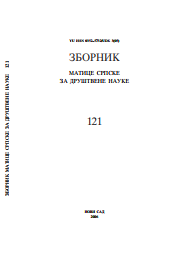ВИТАЛНЕ КАРАКТЕРИСТИКЕ, ОБРАЗОВНА СТРУКТУРА И ПЕРСПЕКТИВА ВОЈВОЂАНСКИХ МАЂАРА
VITAL CHARACTERISTICS, EDUCATIONAL STRUCTURE AND PERSPECTIVE OF THE HUNGARIANS FROM VOJVODINA
Author(s): Iren Gabrić-MolnarSubject(s): Education, Geography, Regional studies, Demography and human biology
Published by: Матица српска
Keywords: assimilation; emigration; degradation; vulnerability; positive discrimination;
Summary/Abstract: One segment of the perspective of human resources in a specific region is its demographic development (adequate vital indicators), as well as a proper educational structure of the active population. Among other things, the essence of the development of Vojvodina is the improvement of its human potential as a whole and the desire that no community, neither ethnical nor national minorities, should lag behind in it. In the 1990s, the impoverishment and loss of perspective in our country accelerated emigration of the population, as well as the tendency for a relative and absolute decrease in the number of the Hungarians in our region. In 2002, the number of Hungarians was 290.207, which means that in ten years it decreased for 49.284 persons. This is a result of a low birthrate, assimilation, and mostly emigration abroad, usually of young experts with their families. The loss of a significant part of intellectuals, valuable workers, means a great handicap for our human resource in the country, bat also for the national community of the Hungarians. Progress and survival of all nations and nationalities in Serbia depends on their ability to get included in the developmental, economic, cultural trends, their capability at the job market. One of the guarantees that we would catch up with the world is the progress in the school system, professional education of the population and the stability of the economic system. In order to view the position of the Hungarians in the school system in Vojvodina, we analyze their share at the educational levels: the share of Hungarians at different educational levels is not adequate, when we take into account their percentage share in the total population of Vojvodina (14,28%). At the elementary level, the share of the Hungarians in the total number of elementary-school pupils is only 12,31%, at the secondary-school level it is about 11%, but at the high-school level it is barely above 8%. The share of the Hungarians at the university studies is too small (below 6% of the total number of students). Further decrease in the number of students, classes at schools and staff carrying out lecturing in that mother tongue,for the Hungarian community would mean fast degradation. The Hungarians feel threatened, suppressed, and that creates lack of confidence in the dominant nation. For these reasons, the positive discrimination is necessary, special attention towards the threatened communities, to enable the national minorities to preserve their identity and culture, to maintain a stable multiethnic atmosphere in the Vojvodina region.
Journal: Зборник Матице српске за друштвене науке
- Issue Year: 2006
- Issue No: 121
- Page Range: 359-367
- Page Count: 9
- Language: Serbian

